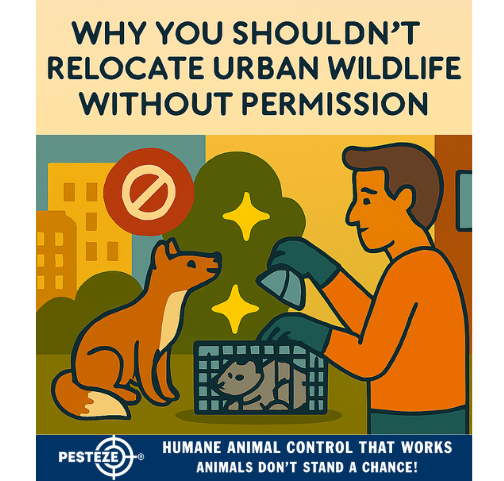WHY YOU SHOULDN’T RELOCATE URBAN WILDLIFE WITHOUT PERMISSION

WHY YOU SHOULDN’T RELOCATE URBAN WILDLIFE WITHOUT PERMISSION
SUMMARY
Relocating urban wildlife may seem like a compassionate solution, but it often causes more harm than good. Without proper knowledge, permits, and planning, relocation can lead to animal suffering, ecological disruption, and legal consequences. This guide explains why you should never relocate wildlife on your own and highlights safer, more effective alternatives. Responsible action protects both animals and communities.
FEATURES
-
Relocation Often Leads to Death: Many animals fail to survive in unfamiliar environments due to stress, predators, or lack of resources.
-
It’s Illegal Without Permits: Most states require special licenses to trap and relocate wildlife, and violations can result in fines.
-
Disrupts Local Ecosystems: Moving animals can introduce disease, disrupt territory balance, and harm native species.
-
Abandoned Offspring Risk: Relocating a mother animal may leave babies behind to starve or die.
-
Another Animal Will Replace It: Removing one animal often opens space for another to move in, repeating the cycle.
-
Safer Alternatives Exist: Humane deterrents, exclusion methods, and professional wildlife services offer better long-term solutions.
GUIDE DESCRIPTION
Urban wildlife is a natural part of city life, adapting to human environments in search of food and shelter. While their presence can be inconvenient or alarming, relocating these animals without permission is rarely the right answer.
One of the biggest misconceptions is that relocation is humane. In reality, most relocated animals die shortly after release due to unfamiliar terrain, lack of food, exposure to predators, or stress-induced illness. They may also be unable to find shelter or navigate new environments, especially if moved far from their original habitat.
Legally, trapping and relocating wildlife is regulated in most states. You must have a permit or be a licensed wildlife control operator to do so. Unauthorized relocation can result in fines or legal action—even if your intentions were good.
Relocation also disrupts ecosystems. Animals carry diseases and parasites that can spread to new areas. They may compete with native species or upset territorial balances, leading to unintended ecological consequences.
Another major concern is orphaned offspring. Many animals, like raccoons or squirrels, nest in attics or crawl spaces. If you relocate a mother without realizing she has babies, those young may be left behind to suffer and die.
Even if relocation succeeds, it rarely solves the problem. Urban areas offer abundant resources, so removing one animal often creates space for another to move in. This cycle continues unless root causes—like food access or shelter availability—are addressed.
Instead of relocation, consider humane deterrents, exclusion techniques, and professional wildlife services. These methods are safer, more effective, and legally compliant.
By understanding the risks and choosing responsible solutions, you help protect wildlife and maintain a healthy urban environment.
- Amy Chang


Comments 0